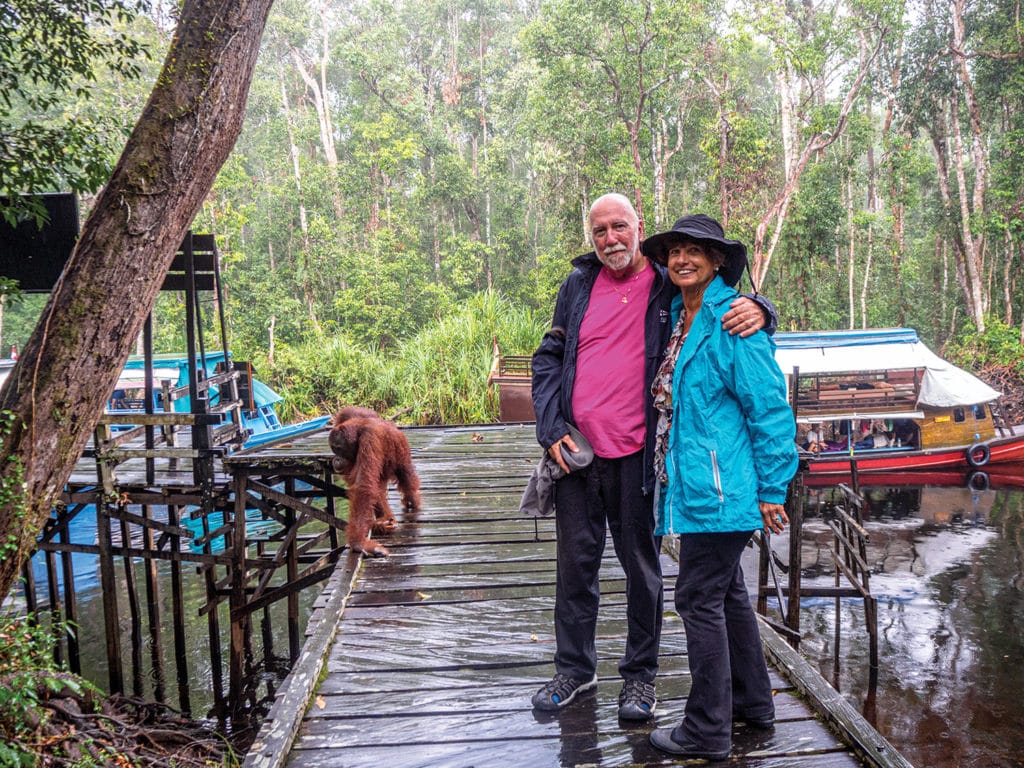
In October 1975, while building our 36-foot ketch Carlotta from scratch, I happened to pick up a copy of National Geographic magazine featuring Borneo. On its cover was what appeared to me to be a sexy hippy chick, with a cute female orangutan on her hip and another on the ground in front of her. The standing orangutan was named Princess. It turns out the women’s name was Dr. Birutè Galdikas, a primatologist and conservationist, which I discovered as soon as I actually stopped to read the story.
But it was that image that spoke directly to me, not merely because of how foxy the doctor looked, but because of its deep-in-the-jungle exoticness. Though I was 23, dead broke, and the lease on our B Street and Congress building site in Boston was expiring, my desire at that time was to sail to the farthest corners of our world. I saw the entire planet as my classroom. Surely Borneo, where they were teaching orangutans sign language, would be a good place to start to learn.
So, with the brashness of youth, I convinced my wife, Carolyn, that once we launched our boat, we should sail there—without even knowing exactly where Borneo was, except that it was far, far away from chilly Boston.
Of course, life got in the way. It always does. Our daughter was born. Hurricanes loomed. Boats sank and others were refloated. Taxes needed to be paid. More shore jobs were offered than I had the energy to turn down. And I’m slow—slow on all levels. But I’m also tenacious, and I clutch my dreams fiercely. Thus, 26 years later, in 2001, I tossed my anchor in the muddy Kumai River across from a sleepy village on Borneo’s south coast, with a lone barefoot man in a dugout canoe rowing toward us.
His name was Herman Herry Roustaman. He was small in stature but huge in personality. He exuded both charm and warmth, and his lust for living was contagious. “What you need, Skipper—you need diesel fuel?”
I admitted I did.
“No problem, Skip!” he said as he grabbed my two fuel jugs, tossed them into his wobbly dug-out, and graciously cleared a place for me amid the bilge water and floating fish guts.
I grimaced as I sat down (while silently cursing myself for going commando that day).
We chatted. I immediately liked him. He was wildly enthusiastic. His grandiose dream was to lure away the local loggers (and thus stop their habitat destruction) with renewable and sustainable profits from tourism. This was all well and good, but I thought that, perhaps, he should first organize the buying of a pair of shoes.
He rowed me to a 55-gallon drum on the shore. It had some oily black fluid floating it in, along with what appeared to be some leaves and a dead rat.
“How many gallons would you like, Skip?” he asked.
I informed Herry that I could buy only clean, filtered diesel fuel. He frowned, thought about it a second, then whipped off his T-shirt, stretched its cotton fabric over his funnel, and poured away.
How can anyone not love such an entrepreneur?
“You like orangutans?” Herry asked as he poured. “I have friend with riverboat, and he likes to cook. We all go see orangutans?”
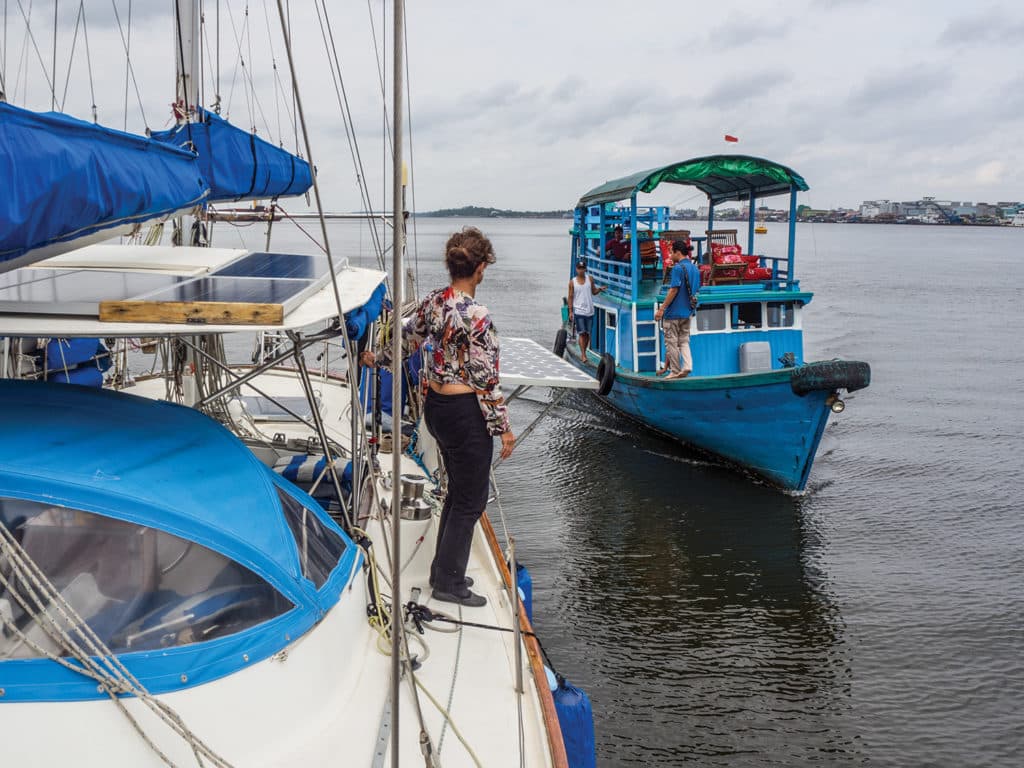
Actually, bits of this convoluted tale began in Africa at about the same time we were building our boat in Boston. In the early 1970s, the highly charismatic Louis Leakey, a British paleoanthropologist and archaeologist working in Kenya, took time out from digging up skulls from his African backyard to send three idealistic women into the world to save the great apes. You probably already know the life stories of two of those dynamic women. Dian Fossey (of Gorillas in the Mist fame) studied gorillas in Rwanda until she was tragically killed by poachers in 1985. And Jane Goodall has won a number of prestigious international awards for her work with chimpanzees. However, few folks know the name Birutè Galdikas. Why? Because Goodall and Fossey were forced to shake the Western money tree to fund their research, while Galdikas just nonchalantly climbed into a tree in Indonesia and started teaching orphaned baby orangutans how to build nests in order to survive in the wild.
She didn’t play the big-money fundraising game. She quietly went her own way, did her own thing, and never kowtowed to “The Man”; she let it all hang out from atop lofty, swaying trees.
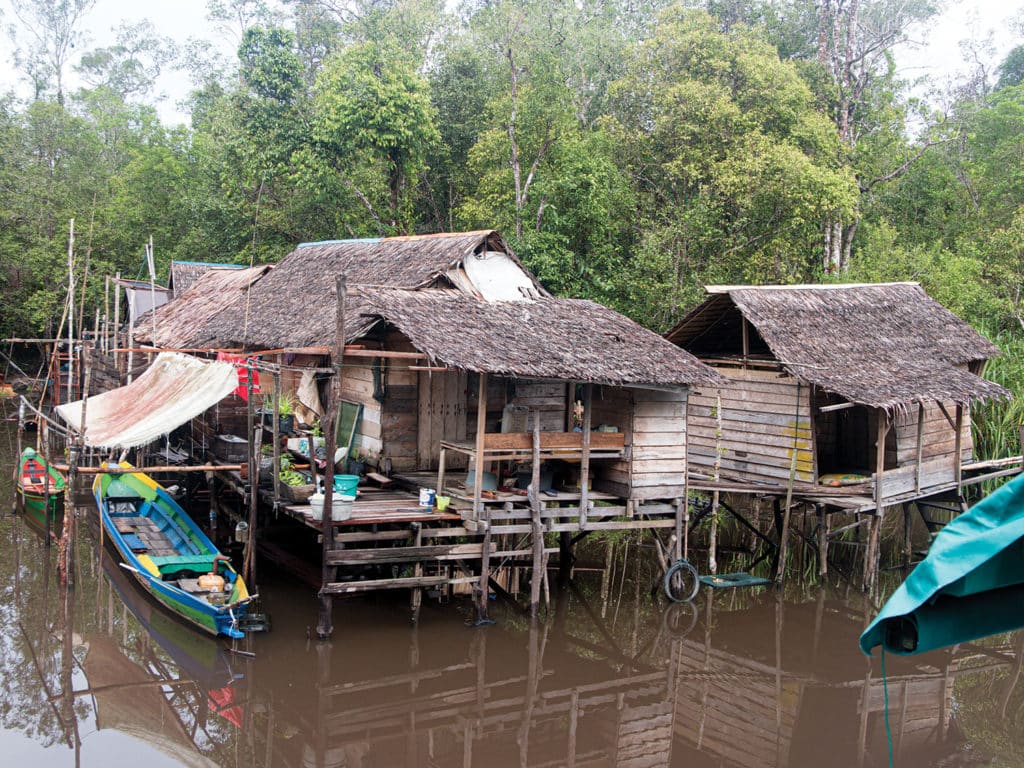
In order to understand the lifelong dedication of Galdikas, you have to understand orangutans. They live to be more than 50 years old. Their young are entirely dependent on their mothers; the fathers play no role in their upbringing. Up until the age of four, they don’t even let go of their mothers. By seven, if they’ve learned their lessons well, they’ll begin to play farther and farther from their mother, until one day—they’re gone.
They’ve graduated.
How does Galdikas find her wards? What are some common reasons orangutans are orphaned? For some, it’s due to intentionally set or accidental forest fires. Mothers are killed by loggers, or some by palm-oil farmers.
Galdikas’ goal wasn’t to take care of orphaned orangutans—it was exactly the opposite. It was to truly mother and mentor them, to teach the babies how to be themselves and to learn the skills needed to survive in the wild. For example, orangutans build a new nest in a new location each day. Thus, nest building is a mandatory, life-enabling skill. Galdikas has built thousands of nests over the years for the edification of hundreds of freedom-aspiring orangutans.
To say this is labor-intensive is a huge understatement. The doctor is nothing if not resolute. She has literally hung in there despite the fact that male orangutans are eight times stronger than their human counterparts, and she often must work with them far off the ground.
No scientist before or since has attempted such a thing for such a sustained period of time, let alone been responsible for 250 clueless baby orangutans returning to the wild as budding adults.
It was into this strange world that we arrived in 2001 with our new buddy-for-life and river-guide-forever Herry at our side. The moment we stepped onto the dock at Camp Leakey, the Orangutan Foundation International’s rehabilitation center founded by Galdikas, we were greeted by a friendly female orangutan making weird gang-member signs at me.
Yes, I’d finally met Princess, who wasn’t merely still alive but in the prime of life.
Herry watched her intently, then informed me. “She’s bored and wants to play. Actually, she’d prefer a snack first. Bananas and milk, perhaps?”
“I can’t believe I’m in the presence of, well, magazine royalty,” I laughed. Then I added, “Where’s the hot doctor?”
“Dr. Birutè is…” Herry said as he pointed a finger to the sky and the dense forest canopy above.
Sure, we could interview her, but only if we could find her. And finding the busy doctor in a rainforest is akin to searching for the proverbial needle in a haystack, assuming the haystack is hundreds of feet tall, thousands of hectares wide, and made of hardwood.
Part of the reason that Galdikas the scientist is so elusive is because the National Geographic article in question helped to spark a giant controversy among linguists over what exactly animal- to-human “speech” and “communication” is. More than one linguist accused her interactions with orangutans as overstepping her scientific bounds.
Back in Borneo, Galdikas didn’t climb out of the trees long enough to reply. After all, why bother when she was riveted by her swaying subjects, not the nitpicking greater scientific community.
Luckily, nobody told Princess of the controversy, and she was able to maintain her sunny disposition.
We spent the ensuing days playing with Princess and the other orangutans, and we met many of the Dayak park rangers, most of whom were just a generation or two away from their headhunting ancestors.
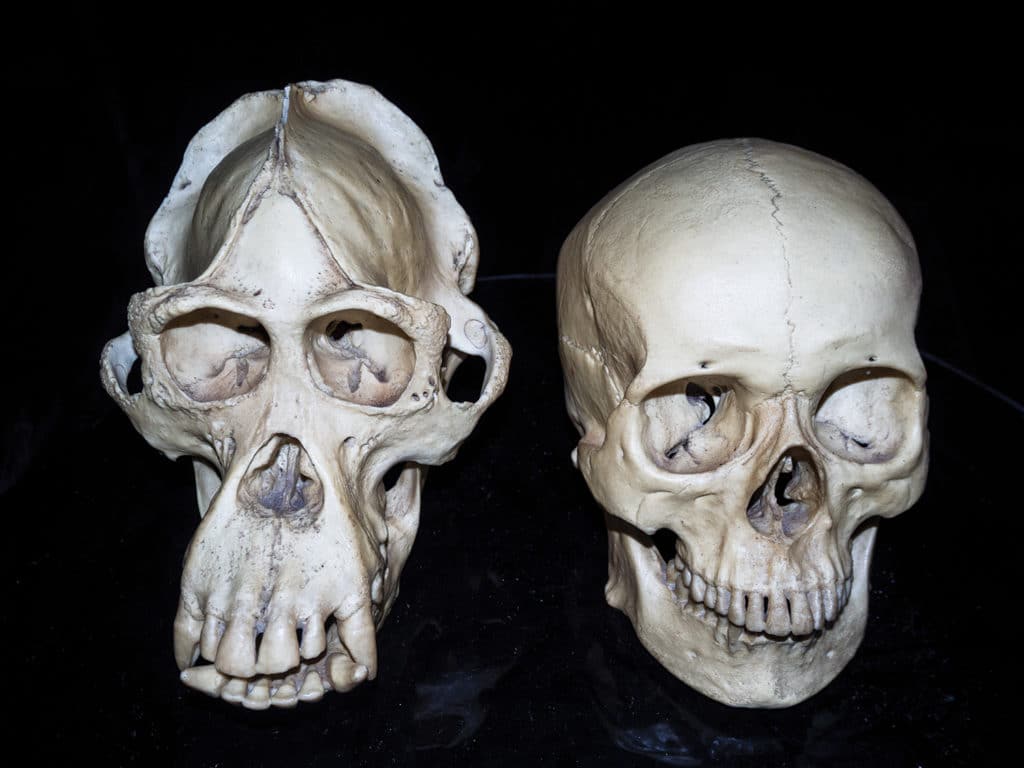
We even met Barry the Gibbon, a small ape that looked more like a monkey without a tail than a great ape. He moves through the dense jungle so fast that you can’t see him, only where he’s been by the shaking of the vegetation.
We were absolutely riveted by the entire otherworldly scene in 2001, but our weather window across the Indian Ocean was opening up. As we departed, never having managed to meet Galdikas, we vowed to return to Borneo ASAP—which turned out to be 18 years later, in 2019, in the midst of our latest circumnavigation.
Now, it is always tricky going back to a cruising destination that has touched your heart because you’re almost guaranteed to be disappointed. But not this time, not for us. Though we’d heard our beloved Princess has passed, if anything, our second visit was better than the first.
Kumai is now a city of 50,000, not a village of 400. Herry not only owns a highly successful regionwide tour agency, but he is also head of the Green Team, a group of environmentally concerned local river and forest guides who chip in their own pennies to buy buffer parcels of land between the orangutans and the palm-oil plantations.
And yes, Herry finally has a pair of shoes. Even better, his hippielike equation suggesting ecology plus orangutans equals wealth is finally coming true for thousands of Indonesians. Illegal logging is way, way down, and the big surging industry in Borneo that is now doing all the hiring is tourism.
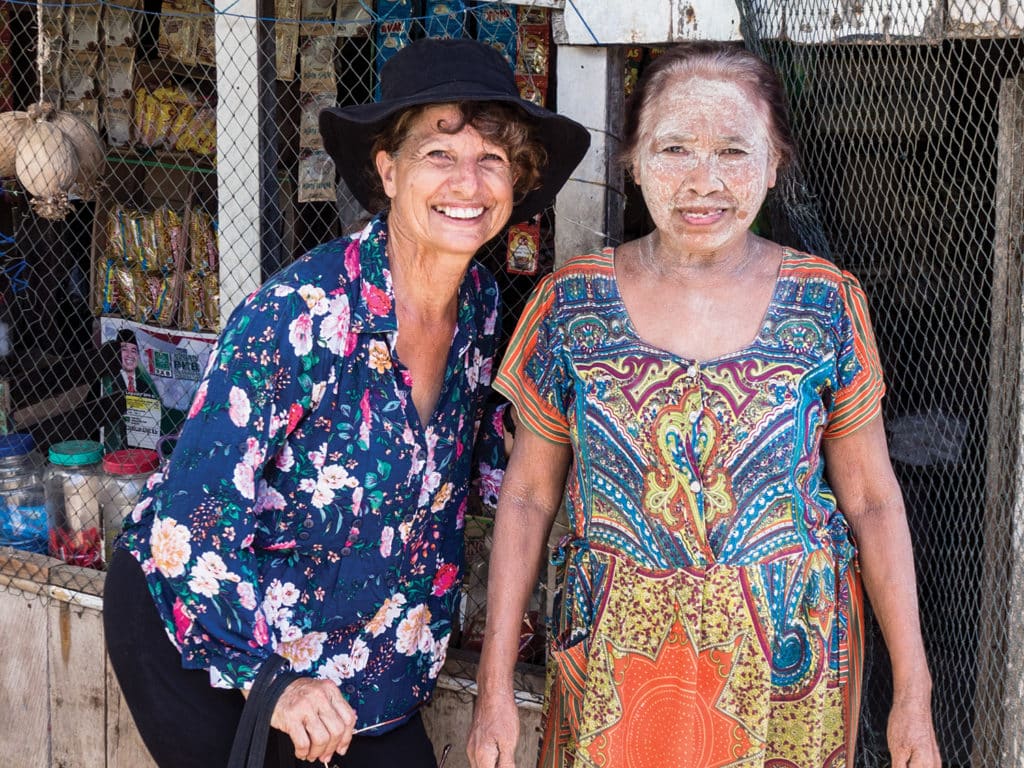
Regardless, getting to Camp Leakey is still a challenge. First, we putt-putted Ganesh, our 43-foot Wauquiez ketch, 20 miles up the Kumai River. We took pains to anchor well because the reversing currents are strong and the occasional squalls fierce. Then we engaged an around-the-clock guard to sit in the cockpit, with the boat locked and alarmed. We then transferred to a shoal-draft, narrower vessel in which we motored an additional 20 miles up the muddy Sekonyer tributary, until the dense jungle vegetation leaning in from both banks began to slow our progress.
As the jungle closed in on us, proboscis monkeys tittered at our foolishness. Owls thought we were a hoot. Monitor lizards—all 7 feet of them—slithered on the riverbank mere feet away. Poisonous sea snakes poked up their heads with interest. Oriental pied hornbills fluttered. Stork-bill kingfishers flew up. And mighty trees shook alarmingly in the distance, a promise of huge beasts to come.
Ah, Borneo! You can’t get more primitive here on Earth without a time machine. Shortly after our third crocodile sighting, we came to a familiar dock. It had barely changed in the intervening 18 years.
I was securing our forward spring line as Princess’ son, Percy, approached. He’s 16 now, and like teenagers everywhere, perhaps a bit wary.
We’d never met.
“I used to know your mother back in the day,” I said, standing stock still.
While I dearly love animals, I’m also a human who has survived thus far because I never forget that a wild animal is a wild animal.
Percy approached. I stood my ground and forced myself not to smile. A show of teeth indicates a desire to fight.
Carolyn was more cautious. She stepped back on the boat.
“Careful,” she hissed to me. “Don’t grin, don’t establish eye contact, don’t act aggressive!”
Ah, the tricky social situations you find yourself in while world cruising!
Once Percy got our measure, however, there was no problem, other than his openly coveting Carolyn’s iPhone. He even lazily guided us into the reception area.
I couldn’t help but be proud that we were meeting an entirely new generation of orangutans this circumnavigation—and that in primitive Borneo, the more things change, the more they stay the same.
Cap’n Fatty and Carolyn Goodlander are now anchored back in their beloved Singapore, aboard their ketch, Ganesh, swinging through the Asian skyscrapers.








